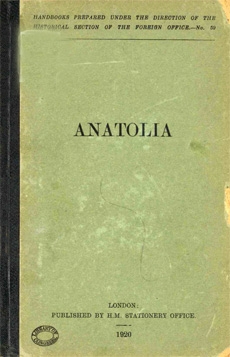Table of contents
I. Geography physical and political
(1) Position and Frontiers / 1
(2) Surface, Coasts, River System, and Lakes
Surface and Coasts / 1
River System / 4
Lakes / 5
(3) Climate / 5
(4) Sanitary Conditions / 7
(5) Race and Language / 7
(6) Population / 8
II. Political history
Chronological Summary / 9
(i) Introductory
Ethnical Boundaries / 9
Origin and Composition of Population / 10
"Osmanli" and " Turk " / 11
(ii) The Turkish Conquest /14
(iii) Effects of the Conquest
Racial / 18
Social / 21
Economic / 22
III. Social and political conditions
(1) Religious
Religious Organization / 25
Mohammedanism / 25
The Orthodox Church / 26
The Armenian Church / 27
(2) Political
Form, Character, and Methods of Government / 28
(3) Public Education / 30
(4) Social / 31
(i) Moslems and Christians / 33
Moslems / 33
Christians / 34
Armenians / 35
Relations of Moslems and Christians / 35
(ii) Turks and non-Turkish-Moslems / 36
IV. Economic conditions
(A) Means of communication
(1) Internal
(a) Roads / 39
Sanjak of Ismid / 39
Vilayet of Brusa / 40
Sanjak of Bigha / 40
Vilayet of Aidin / 40
Vilayet of Kastamuni / 40
Vilayet of Angora / 41
Vilayet of Konia / 41
Vilayet of Adana / 41
(b) Rives / 42
(c) Railways
(i) Existing Railways / 43
The Anatolian Railway / 44
The Baghdad Railway / 45
The Smyrna-Aidin (Ottoman) Railway / 48
The Smyrna-Kassaba Railway / 51
The Mersina, Tarsus and Adana Railway / 54
The Mudania-Brusa Railway / 55
(ii) Projected Railways / 55
Chanak to Smyrna / 55
Italian Railways / 56
Zonguldak to Bolu / 57
(iii) General Remarks / 58
(2) External
(a) Ports and Shipping / 59
(i) Black Sea Ports / 59
Sinope, Ineboli / 59
Zunguldak, Koslu Bay, Heraclea / 60
(ii) Marmara Ports / 60
Ismid / 60
Geumlek, Mudania, Panderma / 61
Chanak / 62
(iii) Mediterranean Ports / 62
Aivali / 62
Dikeli, Smyrna / 63
Marmarice / 66
Makri, Adalia, Mersina / 67
Ayas / 68
(B) Industry
(1) Labour
(a) Supply / 69
(b) Emigration and Immigration / 72
(2) Agriculture
(a) Products of Commercial Value / 73
Sanjak of Ismid / 74
Vilayet of Brusa and Sanjak of Bigha / 75
Vilayet of Aidin / 75
Vilayet of Kastamuni / 76
Vilayets of Angora and Konia / 77
Vilayet of Adana / 78
(b) Methods of Cultivation / 79
(c) Forestry / 82
Sanjaks of Ismid and Bigha, Vilayet of Brusa / 83
Vilayets of Aidin, Kastamuni and Angora / 84
Vilayets of Konia and Adana / 84
(d) Land Tenure / 85
(3) Fisheries / 85
(4) Minerals
(a) Natural Resources / 85
Coal / 86
Lignite / 87
Lead / 88
Chromium / 89
Emery / 90
Meerschaum, boracite (pandermite) / 91
Other minerals / 91
(b) Output / 93
(5) Manufactures / 94
Sanjak of Ismid / 95
Vilayet of Brusa / 95
Sanjak of Bigha / 96
Vilayet of Aidin / 96
Vilayets of Kastamuni and Angora / 98
Vilayets of Konia and Adana / 99
(6) Power / 99
(C) commerce
(1) Domestic
(a) Character of Trade / 100
(b) Towns, Markets, Fairs / 102
(c) Organizations to promote Trade and Commerce / 102
(d) Foreign Firms and Companies / 103
(e) Methods of Economic Penetration / 104
2) Foreign / 105
(a) Exports / 106
(i) Quantities and Values / 106
(ii) Countries of Destination / 108
(b) Imports / 109
(i) Quantities and Values / 109
(ii) Countries of Origin / 111
(c) Comparison of Exports and Imports / 113
(d) Customs and Tariffs / 114
(D) Finance
(1) The Ottoman Public Debt
(a) History up to 1914 / 115
The Six Contributions, 1879 / 115
The Decree of Muharrem, 1881 / 116
The Decree Annex, 1903 / 119
Later Liabilities, 1908-1914 / 120
Results of the Decrees / 122
(b) Development of Ottoman Public Debt during the War / 124
Loan operations with Germany / 124
Analysis of the War Debt / 125
(2) Turkish War Budgets and Deficits / 128
(3) Taxation / 129
(4) Banking / 132
(E) General remarks
Recent Development of Industry and Commerce and Future Possibilities / 133
Authorities / 138
Maps / 138
| 